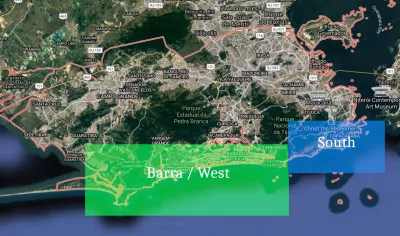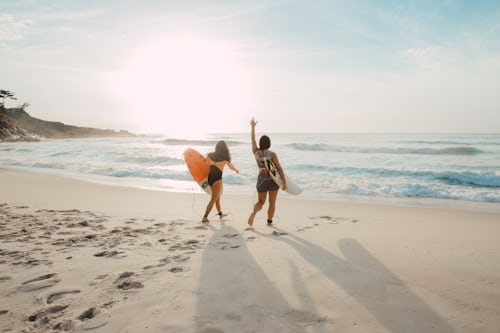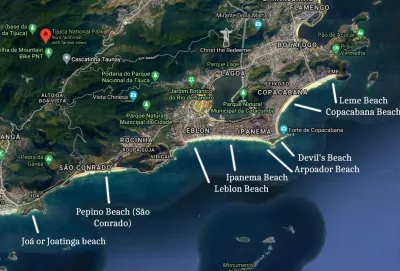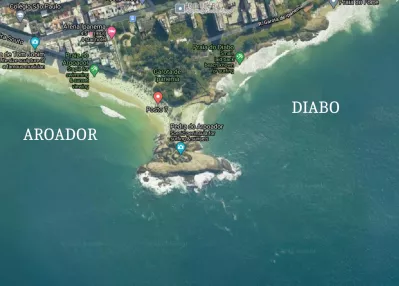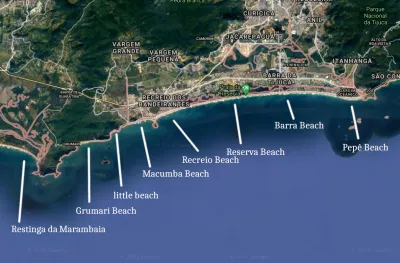Best Surf Spots in Rio de Janeiro
- Where to Surf in Rio de Janeiro?
- 1. Surf in the South Zone of Rio de Janeiro
- Leme Beach and Copacabana Beach
- Devil's Beach and Arpoador Beach
- Ipanema Beach and Leblon Beach
- Pepino Beach (São Conrado)
- Joá or Joatinga beach
- 2. Surfing in Barra and the West Zone of Rio de Janeiro
- Pepê Beach
- Barra Beach and Reserva Beach
- Recreio Beach
- Macumba Beach
- little beach
- Grumari Beach
- little beach de Barra de Guaratiba e Restinga da Marambaia
- Conclusion
- Frequently Asked Questions
Where to Surf in Rio de Janeiro?
Rio de Janeiro has some of the most beautiful and famous beaches in the world. Despite being always full, surf lovers do not feel neglected by the city's beaches. Quite the contrary ... there are waves for almost every taste.
In the South Zone, in general, the peaks are a little more fickle and are only good in a few periods of the year. We must emphasize that when they are good, the quality of the wave is very gringo envy. When the sea is small, the peaks are perfect for beginners.
In Barra and Zona Oeste, the wave is usually stronger and the peaks work more consistently. Although the sea is small at times, it is recommended that adventurous beginners know how to swim well, as in most cases, the surf is far from the sand and there is some current.
In this post, I decided to talk briefly about each beach in Rio de Janeiro and their main surfable spots. In the future, I will make more detailed posts about each beach and about the “secret spots” of the wonderful city.
Best beaches and surf spots in Rio De Janeiro zones1. Surf in the South Zone of Rio de Janeiro
Best spots for surfing in Rio De Janeiro south parth- Leme Beach and Copacabana Beach
- Devil's Beach and Arpoador Beach
- Ipanema Beach and Leblon Beach
- Pepino Beach (São Conrado)
- Joá or Joatinga beach
Leme Beach and Copacabana Beach
Looking at the image above, from right to left, Leme beach is the first beach in Rio de Janeiro that can present surfing conditions.
The left corner of the beach is protected by a rocky wall and breaks only under special conditions. The best swell is from the east, but it can also work with southeast or south. The best wind is from the east.
The waves can reach up to 2 meters on the biggest days and the tip is to try to go at the highest tide, because when it is dry, they are very breakable, surfable only by bodyboarders. The bottom is sandy and not very deep. There is also not much current.
Copacabana beach will rarely be able to surf. The only points that may surprise you are post 5 and the shore-break (flagstone on the border between Copacabana and the Devil).
The canopy shore-break, however, as it has a shallow stone bottom and strong short tubular waves to the right, is not advisable for surfers, only for bodyboarders. To work, the peak needs southwest or south swell and south wind. To reach the peak, a 5 to 15 minute stroke is required.
Station 5 can operate in winter. With very special conditions, there may be a phenomenon known as Sorriso, with strong and short waves of up to 3 tubular meters breaking to the right and to the left. The best wind is the southwest that enters the land and the best swell is the south / southeast.
Devil's Beach and Arpoador Beach
The access to Praia do Diabo is through Arpoador itself or through the Garota de Ipanema park. It is a beach partially closed by military space and access to sand is only allowed in the right corner. However, the water is free for surfing and can work with very large and strong waves in some parts of the year. It is not a beach for beginners, as it also has a current and the formation of waves is very irregular.
Works with south or southwest swell and southwest or no wind. When the southwest ends with most of the beaches in the South Zone, it is always worth checking out the Devil. Great chances of finding half meter waves breaking. On the biggest days, the waves will reach 1.5m and break to the right and left.
Arpoador beach, or Arpex as some surfers say, is one of the greatest symbols in the history of surfing in Rio de Janeiro, Brazil and, perhaps, worldwide. It has already hosted important surfing championships, such as WCT and WQS and, along with Quebra-Mar, in Barra da Tijuca, was one of the birthplaces of surfing in Rio. It is a peak that can please from beginners to experts, depending on the day , and people of any age, however, respect the locals if you plan to fall there. The crowd is also very large and, being one of the postcards of Rio de Janeiro, there are many bathers, so it is recommended to surf there on early weekdays to escape peak hours. Another option is night surfing, since since 1989 the beach has reflectors that increase nighttime visibility.
The best swell is from the east and also works with a swell from the southeast. The best wind is from the east and there is not much current. The waves can reach up to 2.5m on the best days, but you will usually find half a meter breaking to the left. In the best days, known as Arpoador Classic, the quality of the wave is really very good.
Ipanema Beach and Leblon Beach
The two beaches operate under the same conditions, with the exception of the right corner of the Leblon, which may work better. Both Ipanema beach and Leblon beach are very fickle with very irregular waves that are usually short, tubular and break close to the sand, the famous breakers. The best points are post 8 and post 11. The best swells are those from the south and southeast, and the best wind is from the northeast. The waves reach 1.5m and break on both sides.
The Leblon corner has a wave of much more quality than the middle of the beach. It is also not a peak for beginners. Breaking to the right, the waves reach more than 3 meters in the worst undertow, but are usually between 0.5m and 1.5m. The best swells are those from the south and southwest and the best wind is from the north.
Pepino Beach (São Conrado)
Pepino beach has 3 completely different surfable spots.
In the left corner, the waves are very strong and tubular and, therefore, demand a lot from the surfer in terms of positioning, rowing and drop. It is not recommended for beginners, because in addition to the qualifications already mentioned, the surfer must have a lot of speed control to know the right section to get out of the tube without taking the wave on his head, if that is possible. If you decide to fall there, respect the locals. The best swells are from the east and southeast and the best wind is from the east. The waves reach up to 2 meters.
The middle of the beach is much more fickle and may have short lefts with an east swell and rights with a south or southwest swell. The waves vary from 1m to 1.5m and in general are breaking waves. The best wind is from the east.
The right corner is protected from the southwest wind and can provide good rights, depending on the day. The waves are strong and tubular and break on both sides. The best swell is the southwest or south and the best wind is the southwest. It would be a very beautiful region due to the proximity of Pedra da Gávea, Pedra Bonita and Pico Dois Irmãos, in addition to the sight of the colors of hang gliders, were it not an area punished by sewage pollution and brought by rain.
Joá or Joatinga beach
Access to Joatinga beach is not so simple. The descent is made by stones from a residential condominium on Estrada do Joá, but this beach fell in favor of the carioca a few years ago due to the beautiful view and the high potential waves.
With east swell, low tide and light winds, the left corner forms perfect tubular waves to the left. The waves are stirred by all the winds, except from the east. The middle and the right corner are more irregular and end up being preferred by bodyboarders.
When the sea is not large, it is a good peak for beginners. With a large sea it is not recommended, as there is no well-defined channel for entry and the waves lose formation.
2. Surfing in Barra and the West Zone of Rio de Janeiro
Pepê Beach
The stretch of sand that runs from Quebra-Mar to Pontão do Recreio is the largest continuous stretch of beach within the city, if we disregard Restinga da Marambaia, which is a military area. The first stretch is known as Pepê beach, which runs from Quebra-Mar to Av. Érico Veríssimo and already presents some beautiful surfing opportunities.
The Quebra-Mar, along with Arpoador, was considered the best peak in Rio in the 70s and 80s, because of its perfectly tubular waves. Today it suffers from the dumping of dirty waters from the Tijuca lagoon and from surfers who want to impose their localism.
Even so, if you want to surf there, the best conditions are presented with swell from the southeast and, mainly from the east. The waves are usually 0.5 to 1.5 meters, but can have peaks of up to 3 meters. The best wind is from the northeast or weak east.
Right after the Breakwater, there is a point known as postinho. It is the current location of the WCT stage in Rio de Janeiro and also breaks high waves. The advantage of this peak is that when the other waves in Barra are closing, it usually continues with quality waves and better formation.
The best swells for the postinho are southwest and south and the best wind is the southwest. The waves vary from 0.5 to 2.5 meters. Along the entire length of Barra beach, from the beach to the reserve, beginners should be careful. Although with a small sea it is one of the best places to learn, it is a beach that has a current and surf away from the sand.
WCT 2014 in the post:
Barra Beach and Reserva Beach
Barra beach and Reserva beach do not have the right spots for surfing. Virtually the entire length of the beach is surfable depending on conditions. The ideal is to travel the beach by car and observe the best place with the best waves.
At Barra beach, points are marked by posts 4, 5, 6 and then Alfabarra, almost on the reservation. It is a beach that receives waves from the east, southeast, south and southwest. The best wind is the north wind. In short, it is difficult to get to Barra and not find any usable wave.
The great advantage of Praia da Reserva is the absence of a crowd. Some stone slabs also encourage the formation of good waves. The disadvantage is that the wave may be closing too much and, in addition to having some current, the surf is further away from the sand. The ideal waves are between 0.5 and 1.5 meters. Above that it closes. It welcomes swell from the east, southeast and south and the best wind is the northern land.
Recreio Beach
Recreio beach has several ditches in the middle of the beach on days of small sea, powerful rights on days of large swell and the point that is the corner of the beach, totally protected from southwest winds.
The corner of the beach breaks best with an east swell. With south and southwest swell, the best waves end up being further away from the corner. Two famous points are the post 9 and the area in front of Rua Glauco Gil. The best wind is the northern terral and the waves vary from 0.5 to 3m in the largest swells.
Although the waves break both ways, with low tide and large swells of up to 8 feet, the rights can be really long. When the sea is small it is ideal for those just starting out in the sport. If you are going to surf there on a weekend, be aware of the huge crowd that will be faced.
Macumba Beach
Macumba beach is the beach that is after the pontal stone at the end of Recreio. It is one of the most constant wave beaches in Rio de Janeiro. The surf works almost the whole year, mainly with swell of south or southwest. It is one of the best beaches to surf when the sea is big in Rio de Janeiro, as the waves are full and do not close very often. The best wind is from the north.
Due to the characteristic of their full waves, longboard surfers are the majority in the line-up. For surfboard, the waves work best in the left corner of the beach and / or when the tide is low. The waves reach 0.5 to 2.5 meters and can be quite long.
Macumba is also an excellent spot for those just starting out in surfing, but it requires good physical preparation. The full waves indicate that it does not take much skill or experience to surf in the area, however the surf away from the sand and the lack of a clear channel for entering the peaks show that surfing may not be such a simple experience there.
little beach
The little beach is another example of a peak in Rio with a lot of constancy and quality in the waves. Works with any swell, mainly south, southwest and east, with north or southwest land. However, it has a certain crowd. If you don't get there extremely early, the chance of being able to stop the car is almost zero.
If you are one of the lucky ones who managed to park at the peak, you can find waves of up to 3 meters. As it is a peak that supports all types of waves, it is difficult to trace a predominant characteristic for surfing, you have to go in the day and check it out. The right corner has waves just to the right and the left corner, taking even farther sections to the middle of the beach, has waves for both sides.
It would be an excellent beach for learning to surf on days when the sea is smaller, but it is frequented by the best surfers in Rio and even in Brazil, making it difficult for a beginner to catch good waves.
Grumari Beach
Grumari is an extensive beach with strong and tubular waves, excellent for surfing. On smaller days it is interesting for beginners, but on larger days it is better to leave it to the professionals. The waves vary from 0.5 to 3 meters and the beach has dangerous days with very strong currents.
When the sea is small, any wave direction works for surfing. When it's big, just south or southwest. The best winds are northwest and west. In the right corner, southwest is surfable. In the middle of the beach, the bottom is always changing and it is difficult to predict whether the best wave will be to the right or left. In the right corner, the bottom is more stable, forming a good peak of rights. On big days when the best conditions are met, it is one of the best places in town to surf big waves.
Grumari beach is located in a forested area, isolated from the city and residential areas. Therefore, we do not recommend that you stay until after dark on the spot.
little beach de Barra de Guaratiba e Restinga da Marambaia
Barra de Guaratiba is the last neighborhood in Rio de Janeiro with beaches before the marambaia restinga. The difficulties that surround this surfing point make one of the best waves in the city little known by cariocas.
Among the difficulties, we highlight the distance from large centers, as it is more than 1 hour from the center of Rio, the strong localism in the region, the fact that it is a wave for experts when it breaks in its best conditions and the difficulty of parking combined with few public transport lines with access to the place.
the best surf spot is at the little beach of guaratiba, a small strip of sand at the exit of the channel that connects the mainland river to the maringaia restinga. Breaks only in special conditions, with swell from south or southwest and winds from northeast and east. When these conditions are reached, the waves are perfect tubular and can be long as they continue to rest in the marambaia, resembling Balinese waves. They reach 0.5 to 2 meters.
Conclusion
As mentioned before, I hope I have shown that Rio has wave types for all surfing tastes, experiences and ages. Now that you have a wave guide for the city, in the same place, just go to wave forecast sites like Windguru, Brasil Surfline or Rico Surf, research the condition of the waves and wind for the next days and decide the its peak. The adrenaline team10 wishes you to have beautiful waves!
Soon we will post about each peak specifically and about other cities in Brazil. It would be great to hear your opinion on what should be next. =)
Frequently Asked Questions
- Is Grumari beach a good surf beach?
- Yes, Grumari is an extensive beach with strong hollow waves, great for surfing. On the small days, it's fun for beginners, but on the big days, it's best left to the pros. The waves range from 0.5 to 3 meters and there are dangerous days on the beach with very strong currents.
- What makes these surf spots in Rio de Janeiro stand out, and what range of surfing skills do they cater to?
- The best surf spots in Rio offer a mix of wave types, from gentle breaks for beginners to challenging waves for advanced surfers. Locations like Arpoador and Prainha are renowned for consistent waves, beautiful scenery, and vibrant local surf cultures.

